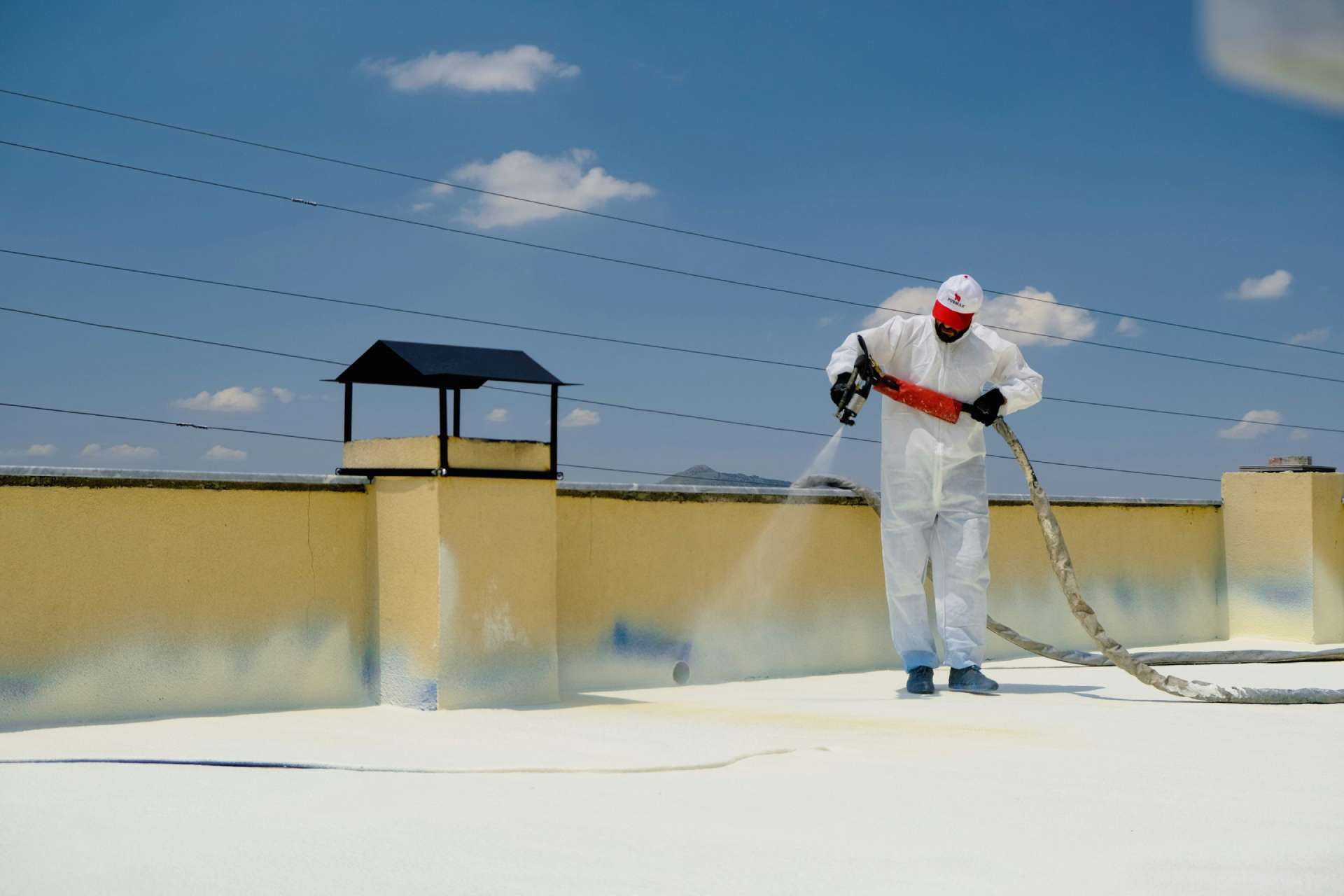Spray polyurethane foam is a fantastic product. It provides many benefits. When properly installed, it:
- Provides a seamless covering of the roof surface, leaving no joints or laps to open and leak
- Provides additional insulation. Foam has an R-value of approximately 6.0 per inch. The mass of foam provides a thermal block for heat or cold transference
- Provides a measure of soundproofing. The interior of the building is quieter, since exterior noise is minimized or blocked
- Minimizes ponding. If there are areas of the roof that have sagged or tend to pond, additional foam can be added at those areas to reduce that problem without adding significant weight to the roof
- Minimizes thermal shock. Thermal shock is the result of rapid contraction or expansion of a roof system due to exposure to heat or cold. The best example is a cold monsoon rain hitting a hot roof system. The roof system tries to contract rapidly due to rapid cooling, but contracts unevenly due to different materials being involved. This can lead to cracks or tears in the roof system. Foam is inert. It doesn’t react to heat or cold, so this risk is minimized
- Is easy to maintain. Once a year the roof should be walked, with any minor damages being repaired with a quality exterior-grade elastomeric or urethane caulk
- Is durable. A foam roof is intended to last for decades. And it will, so long as it is properly maintained
Maintaining a foam roof includes the following:
- Walking the roof at least once per year to identify minor damages, repairing with an exterior-grade elastomeric or urethane caulk
- Ensuring the foam is protected from the damaging ultra-violet rays emitted by the sun. This is accomplished by periodically coating the roof with a quality elastomeric acrylic. The term “elastomeric” refers to the coating having the ability to expand and contract without cracking or separating. Resins added to the coating when it is being manufactured provide this ability. Titanium is also added in the manufacturing process. Titanium reflects the sun’s rays, blocking them from passing through the coating and damaging the foam beneath. It’s critical that the amount and type of resin and titanium added to the coating be sufficient and of a quality to effectively perform
- Applying sufficient coating. Once applied, coating thickness is referred to as “dry mils”. Coating degrades over time when exposed to sunlight and weather. To provide maximum protection, it is best to ensure the foam roof has a minimum of 20 dry mils of coating on it. This can be achieved by applying 2 coats of quality elastomeric acrylic roof coating about every 5 years
Common problems with foam roofs
- Lack of maintenance. Not walking a foam roof at least once per year risks letting minor issues grow to become more significant problems. Bee holes, bird pecks, tree scrapes, etc. will leave foam exposed to the sun, resulting in burned foam and possibly even leaking. Over time the burned area will expand
- Lack of coating. As the coating burns off over time, the foam beneath will be exposed to the sun. UV-rays will burn the foam, and over time degrade the foam. This is visible as a dark orangish crumbly surface, which turns to dust when rubbed. If this happens, the roof will need to either be torn off or scarfed (a machine much like a lawn mower, which grinds the top layer of foam), then re-foamed
- Unethical contractors. Unethical contractors will apply inferior coating products (too little titanium and resin, poor quality resins, or both) or too little coating. Both will cause problems. The coating will burn off, leaving foam exposed to be burned by the sun. Applying low-quality coatings may seem to save money today, but there is a price to pay for “cheap”. The contractor who applies one layer of coating with a 5-year warranty is cheating the customer, since by the time the 5 year warranty period is over, although the roof may not have leaked, it is quite likely the foam will be burned due to sun exposure, necessitating more expensive work to remediate
- Hail. Hail will damage foam if the hail is large enough. This risk can be minimized by heavy application of granules (70+ lbs per 100 ft2) over wet top coat. Coincidentally, applying granules will also reduce the likelihood and extent of damage from bees and birds, together with extending the duration until the next application of coating
Silicone can also be applied as a coating over foam roofs. We have done this, yet we don’t offer this as a first choice, since once silicone is applied over a foam roof, your options are limited. Silicone can only be coated over by a silicone that is of similar or better quality. We generally suggest silicone be applied only (1) as a last resort to salvage an otherwise damaged roof sytem; or (2) where an extended time period between coatings is desired and the potential risks are known.
When you are considering what to do with your foam roof, call SUNVEK. We’ll assess the condition and provide recommendations for any necessary maintenance. We can be reached at 623-Fix Roof (349-7663) and online at info@sunvek.com.


